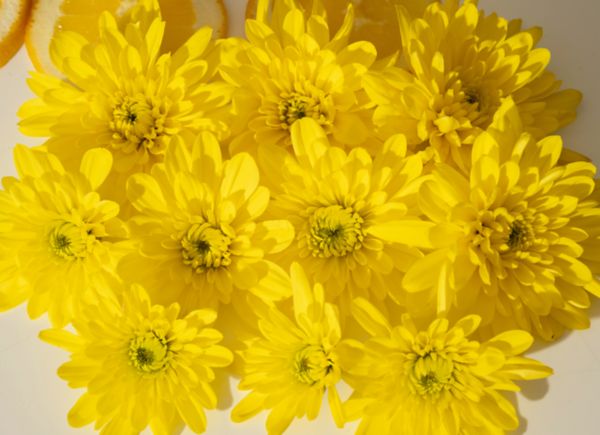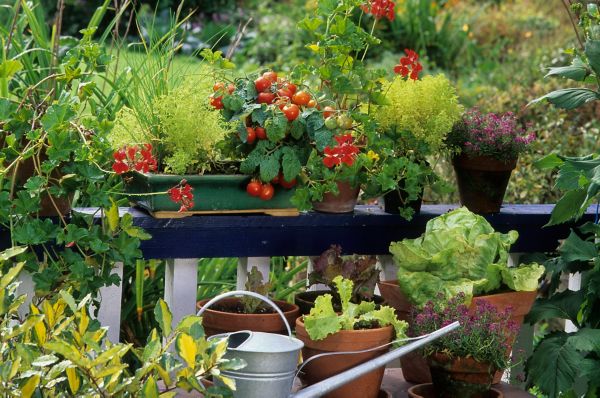How to Grow Blueberries
Authored by Leah Chester-Davis
Eat blueberries fresh, toss them into pancakes, muffins, or cakes, make jelly or jam, puree them into smoothies, add them to salads, or prepare salsas for meat dishes. Plant a few blueberry bushes and you will reap the benefits year after year.
Blueberries are a great fruit for home gardeners. The blueberry plant produces tiny blue fruit that is packed with flavor and an abundance of health benefits that give it the status of a superfood. The blue color signals that it is high in anthocyanin, which researchers believe has anti-aging properties, helps boost the immune system, and helps fight inflammation, heart disease, cancer, and other diseases.
While there is plenty to love about this plant when it comes to its contributions to good health and the culinary world, it also has value as an ornamental plant. In the spring it has white to pink blooms, in the summer a bounty of fruit, and in the fall striking foliage that turns from its usual blue green to yellows, bronzes, oranges, purples, and reds.
About blueberry
| Botanical name: | Vaccinium corymbosum; V. virgatum |
| Common name: | Highbush Blueberry; Rabbiteye Blueberry |
| Plant type: | Perennial shrub |
| Size: | 1.5- to 12-feet, depending on type and cultivar |
| Sun exposure: | Full sun for best yield; tolerates some shade |
| Soil type: | Acidic, well-drained |
| Soil pH: | 4 to 5.2 |
| Hardiness zones: | Numerous zones; your zone may dictate cultivar and when to plant |
| Average first frost: | Varies by region |
| Average last frost: | Varies by region |
| Container friendly: | Yes |
| Beginner friendly: | Yes |
Growing
Blueberry plants need full sun though they can handle some shade, but it will reduce their fruit yields.
This plant prefers well-drained, acidic soil that is rich in organic matter. A pH in the 4 to 5.2 range is best, which is quite different from most other fruits and vegetables so plan accordingly when determining where to site this plant.
A soil test is important to determine your soil’s pH level. Test early enough to make adjustments to your soil in the fall before late winter or early spring planting. Check with your local Extension office for soil test kits and guidelines.
In the absence of a soil test, some state Extension recommendations are to mix into your soil 1 cubic foot of peat moss with an equal amount of sand that does not contain a liming material. However, due to increasing environmental concerns about sphagnum peat mining, Minnesota Extension recommends amending the pH with elemental sulfur, available in garden stores. It may be called soil acidifier or soil sulfur/Sulphur. Follow the label directions.
Blueberry plants grow slowly so by planting now you should have a harvest in 2 to 3 years.
These are the terms you will likely come across when purchasing blueberry plants, depending on your region.
Northern Highbush is the most grown type in the country. This type does not perform well in hot, Southern states unless in mountainous areas. They are self-fertile but benefit when two to three cultivars are interplanted to improve cross-pollination, which can improve fruit size.
Southern Highbush hybrids are derived from crosses of Northern highbush and native Southern species. They have greater tolerance for high summer temperatures, particularly in Southern regions of the country. Most are self-fertile but can benefit when more than one variety is planted.
Lowbush are also called wild blueberries and are grown mostly in Maine from managed wild stands though some cultivars are available. They are difficult to grow in most regions of the country.
Rabbiteye are considered the most adaptable, productive, and pest-tolerant of any of the cultivated types. They grow well in Southern climates. Plant at least two different varieties to ensure adequate cross-pollination.
Half-high cultivars are a cross between Northern highbush and lowbush blueberries. Generally, they are grown in the Northwest and colder climates such as the Midwest and Northeast. Interplanted with 2 or 3 half-high cultivars for cross-pollination. They make good choices for containers, growing 2- to 4-feet tall.
Blueberry plants grow slowly so by planting now you should have a harvest in 2 to 3 years.
Planting
Depending on your region, planting times may range from fall to late winter and early spring in warmer, Southern locations, to April or May in upper Midwest or Northeast locations. Plant when the soil is dry and can be worked.
Work the soil to about 12-inches deep in an area about 3- to 4-feet wide. Mix 2 or 3 gallons of peat moss or composted pine bark into the soil.
Space blueberries at least 4 to 5 feet apart for highbush varieties, and about 6 feet apart for rabbiteye types. If growing in rows, allow 10 feet between rows for highbush and 12 feet between rows for rabbiteyes.
Plant to the same depth the plants were growing in the nursery or the container. If growing bare-root plants, plant deep enough to cover the uppermost roots with 4 inches of soil. Lightly firm or tamp down the soil with your hand or feet to remove air pockets.
Add 2- to 3-inches of mulch around the base of the plant to help reduce or prevent weeds and to keep soil moisture and temperatures even. Sawdust and pine needle mulch are both acidic and good choices for use around blueberries.
After planting and adding mulch, water thoroughly. Keep the soil moist but not saturated.
If you plan to grow in containers, start smaller plants in a container that is 12- to 15-inches in diameter and 12- to 18-inches deep. As the plant grows, move it to a larger container, one that is at least 24-inches deep and 24- to 30-inches wide. Fill the container with a potting mix specially blended for acid-loving plants or prepare your own 50-50 mix of potting soil and peat moss. Wet the mix thoroughly before planting. Plant the blueberry plant the same depth as it was in its container. Water well and keep the soil evenly moist.
After planting and during the first two years, remove any flower buds or blossoms. Despite how resistant you are to this (yes, we know this is painful), it results in the plant using its energy to form a stronger root system, which results in stronger, healthier, more productive plants.
After the second growing season, thin out the centers of the plants. Remove weak branches. Cut back excessively tall canes. Remove a portion of canes and fruiting twigs to allow for better berry growth on the next season’s crop. Moderate pruning will be needed each year to keep your berry plants healthy and productive.
Fertilizing
- Blueberry plants are sensitive to overfertilization. There is no need to fertilize at the time of planting. Wait until a second flush of growth. Avoid using nitrate fertilizers. Instead use an ammonia-based fertilizer or an azalea fertilizer. Follow the label directions. If you are an organic gardener, use cottonseed or soybean meal or look for organic blends for berries or acidic plants. Make additional light applications in May and July. Apply evenly around the drip line of the plant or about 12 inches from the base of the plant.
- For plants growing in containers, University of Maryland Extension recommends fertilizing with an acidic-based fertilizer in early spring before leaves expand.
Controlling Pests, Diseases, and Other Problems
Blueberries are relatively trouble free from pests and diseases. These tips help reduce threats:
- Purchase good-quality, healthy plants from reputable garden centers or nurseries.
- Give plants a good start with healthy soil.
- Remove any diseased or damaged wood by pruning it out.
- Prune out crowded branches to allow for better air flow to decrease bacterial and fungal diseases.
- Water early in the day at the base of the plant to keep the foliage and fruit dry, which also decreases problems with diseases.
- Excess water may cause root rot and other water-borne pathogens so make sure plants are in areas with good drainage.
- Consider some type of netting to protect berries from birds. Arkansas Extension suggests a type of cage, made from 10-foot treated posts, buried 3 feet in the ground, that support cross-wires and bird netting. Store the netting when not in use and reuse as needed each season.
Harvesting and Storing
If you have removed flower buds and blossoms the first two years, the plants should produce berries the third year. As the blueberries grow, they will turn from green to a deep blue color in the summer. When the berries look ripe, give them a taste test to determine if it is time to harvest. Harvest berries in the morning before the heat of the day.
By year five or six, plants can yield up to two gallons per plant and more as well-cared-for plants grow larger.
Plants can produce 20 years or longer if properly cared for and managed.
Storing
Refrigerate after picking but don’t wash them until ready to eat. They will last several days in the refrigerator.
Freeze to extend the summertime goodness. Wash, drain, and dry thoroughly. Spread them on parchment paper on a cookie sheet and freeze. When frozen, place them in a zip top freezer bag and put back in the freezer. This method makes it easy to remove a few or as many as you like.
Harvest blueberries in the morning before the heat of the day.
Expert Tips
- Check with your county Extension office or with a local garden center or nursery for the best types and varieties for your region and best time to plant.
- Properly prepare your soil to give your plants the best possible growing conditions for greater success.
- Blueberries are self-pollinating but benefit when at least two varieties are planted near one another to increase pollination rate and crop yield. Extend the season with varieties that produce early, mid-season, and late season.
Frequently asked questions
Should I add fertilizer to the hole when planting blueberries?
No. It can burn tender roots.
Why do I need to remove blossoms during the first two years?
This helps the plant put its energy into developing a stronger root system and healthier growth. It will pay off in the long run with better fruit production.
Do I need to plant more than one variety of blueberry for pollination?
Most blueberries, except rabbiteyes, are self-pollinating but planting more than one variety aids cross-pollination and can result in higher yields.





